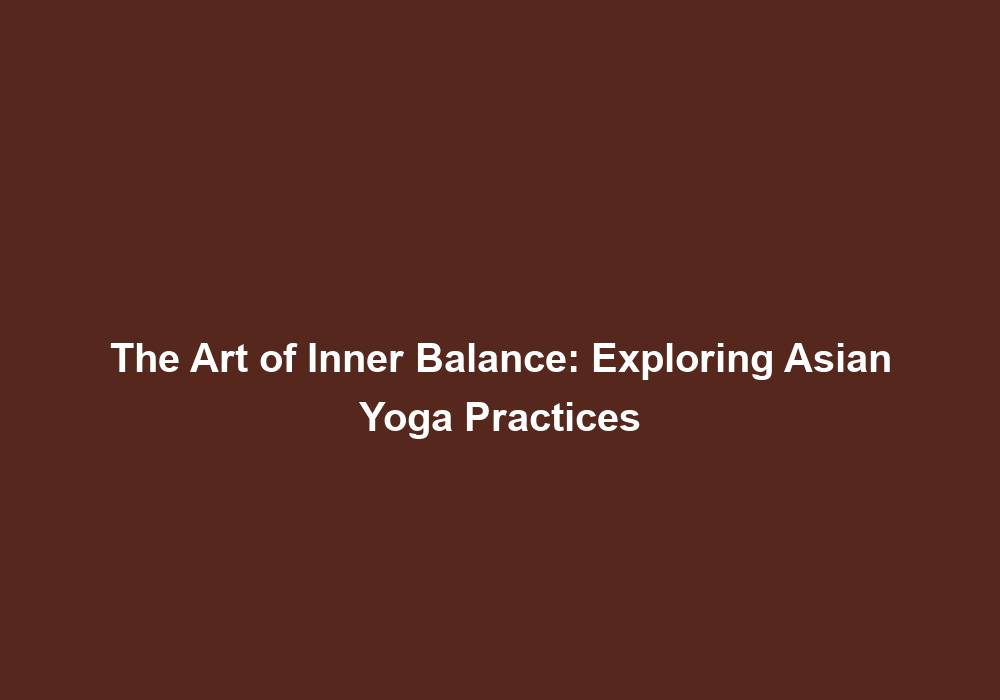The Art of Inner Balance: Exploring Asian Yoga Practices
Yoga, a practice rooted in ancient traditions, has gained immense popularity worldwide. Originating in Asia, yoga has become a way of life for many individuals seeking physical, mental, and spiritual well-being. In this article, we will delve into the art of inner balance through the exploration of Asian yoga practices.
Introduction to Yoga
Yoga is a holistic system that combines physical postures (asanas), breath control (pranayama), meditation, and ethical principles. It aims to harmonize the body, mind, and spirit, promoting overall well-being and self-awareness. Asian cultures, particularly India, Tibet, and China, have developed unique yoga practices that go beyond the physical aspects.
Yoga not only provides physical benefits but also helps individuals cultivate mental clarity and emotional balance. By practicing yoga regularly, one can experience a profound sense of inner peace and tranquility. It allows individuals to connect with their inner selves, gaining a deeper understanding of their thoughts, emotions, and overall well-being.
Moreover, yoga serves as a tool for self-reflection and personal growth. It encourages individuals to explore their inner world and discover their true nature. Through mindfulness and self-awareness, practitioners can develop a greater sense of purpose and find meaning in their lives.
The Origins and Philosophy
Yoga has its roots in ancient India, dating back thousands of years. The term yoga comes from the Sanskrit word yuj, which means to unite or yoke. It emphasizes the connection between the individual self (jivatman) and the universal consciousness (paramatman).
Asian yoga practices embrace the philosophy of finding balance and harmony within oneself and the surrounding environment. They emphasize the interplay between opposing forces, such as Yin and Yang, and seek to achieve a state of equilibrium.
The philosophy of yoga is deeply rooted in the concept of interconnectedness. It recognizes that everything in the universe is interconnected and that our actions have consequences that ripple through the web of life. By cultivating a sense of harmony within ourselves, we can extend that harmony to our relationships with others and our environment.
Types of Asian Yoga Practices
Hatha Yoga
Hatha Yoga is perhaps the most well-known and widely practiced form of yoga, both in Asia and across the globe. It focuses on physical postures and breath control to prepare the body for meditation. Hatha Yoga classes often include various asanas, pranayama techniques, and relaxation exercises.
Hatha Yoga is a gentle yet powerful practice that helps individuals build strength, increase flexibility, and improve overall physical health. It is suitable for individuals of all fitness levels, as the postures can be modified to accommodate different abilities. Additionally, the controlled breathing techniques used in Hatha Yoga can help reduce stress and promote a sense of calmness.
Kundalini Yoga
Kundalini Yoga, originating in India, delves into the awakening of the dormant spiritual energy within an individual. It involves dynamic movements, breathing exercises, chanting, and meditation to activate the Kundalini energy, said to reside at the base of the spine. Kundalini Yoga aims to achieve spiritual enlightenment and self-realization.
Kundalini Yoga is a powerful practice that awakens and balances the energy centers in the body, known as chakras. Through specific movements, breathwork, and meditation, practitioners can experience a heightened state of awareness and connect with their innermost selves. This practice helps individuals tap into their creative potential and cultivate a deep sense of spirituality.
Tibetan Yoga (Lu Jong)
Tibetan Yoga, also known as Lu Jong, combines physical movements, breath work, and meditation. It draws inspiration from Tibetan Buddhism and aims to balance the body’s energy channels, or Lung in Tibetan. Lu Jong exercises involve a series of precise movements and postures to promote physical health and mental clarity.
Lu Jong is a unique practice that combines the benefits of physical exercise and meditation. The movements in Lu Jong are designed to activate and balance the subtle energy channels in the body, promoting overall well-being. This practice not only strengthens the physical body but also enhances mental focus and cultivates a sense of inner peace.
Taoist Yoga (Dao Yin)
Taoist Yoga, or Dao Yin, stems from the ancient Chinese philosophy of Daoism. It focuses on harmonizing the body’s energy and cultivating the flow of Qi (life force energy). Dao Yin practices often include gentle stretching, breathwork, and meditation techniques. The goal is to align and balance the body’s energy channels, fostering overall well-being.
Dao Yin offers a holistic approach to wellness by integrating physical movement, breath control, and mindfulness. This practice helps individuals cultivate a strong and flexible body while promoting the free flow of energy throughout the body. By harmonizing the body’s energy, practitioners can experience improved vitality, reduced stress, and enhanced overall health.
Thai Yoga (Reusi Dat Ton)
Thai Yoga, also known as Reusi Dat Ton, is a traditional Thai healing practice that combines yoga-like stretches, self-massage, and meditation. It originated in Thailand and is influenced by Buddhist and Ayurvedic principles. Thai Yoga aims to promote physical flexibility, release energy blockages, and enhance the body’s natural healing abilities.
Thai Yoga is a gentle and therapeutic practice that focuses on releasing tension and promoting healing in the body. Through a series of rhythmic stretches, acupressure points, and deep breathing, practitioners can experience increased flexibility, improved circulation, and reduced muscle tension. This practice also helps individuals cultivate a sense of mindfulness and relaxation.
Benefits of Asian Yoga Practices
Asian yoga practices offer numerous benefits for individuals of all ages and fitness levels. Some of the key advantages include:
-
Physical Health: Regular practice of yoga improves flexibility, strength, and balance. It can also alleviate chronic pain and improve cardiovascular health.
-
Mental Well-being: Yoga promotes mental clarity, reduces stress, anxiety, and depression. It enhances focus and concentration while cultivating a sense of inner peace.
-
Spiritual Growth: Asian yoga practices provide a pathway for spiritual exploration and self-discovery. They encourage a deeper connection with oneself and the universe.
-
Energy Balancing: These practices work with the body’s energy systems, helping to balance and harmonize the flow of vital energy. This can lead to increased vitality and overall well-being.
-
Mind-Body Connection: Asian yoga practices emphasize the connection between the body, mind, and spirit. They encourage self-awareness and mindfulness, fostering a greater understanding of oneself.
By incorporating Asian yoga practices into our lives, we can experience a holistic transformation that extends beyond physical fitness. These practices offer a profound way to cultivate inner balance and harmony, leading to improved overall well-being and a deeper connection with ourselves and the world around us.
Conclusion
The art of inner balance is a journey that Asian yoga practices can guide us through. From the ancient traditions of India to the serene monasteries of Tibet and the philosophical teachings of China, Asia offers a rich tapestry of yoga practices that promote harmony and well-being. By exploring and embracing these practices, we can embark on a transformative journey of self-discovery, finding balance, and cultivating a deeper connection with ourselves and the world around us.







